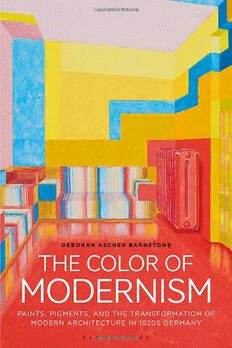
The Color of Modernism: Paints, Pigments, and the Transformation of Modern Architecture in 1920s Germany PDF
Preview The Color of Modernism: Paints, Pigments, and the Transformation of Modern Architecture in 1920s Germany
The Color of Modernism ii The Color of Modernism Paints, Pigments, and the Transformation of Modern Architecture in 1920s Germany DEBORAH ASCHER BARNSTONE 9781350251335_txt_print.indd 3 11/10/2021 15:26:31 BLOOMSBURY VISUAL ARTS Bloomsbury Publishing Plc 50 Bedford Square, London, WC1B 3DP, UK 1385 Broadway, New York, NY 10018, USA 29 Earlsfort Terrace, Dublin 2, Ireland BLOOMSBURY, BLOOMSBURY VISUAL ARTS and the Diana logo are trademarks of Bloomsbury Publishing Plc First published in Great Britain 2021 Copyright © Deborah Ascher Barnstone, 2021 Deborah Ascher Barnstone has asserted her right under the Copyright, Designs and Patents Act, 1988, to be identified as Author of this work. For legal purposes the Acknowledgments on pp. xxi–xxii constitute an extension of this copyright page. Cover design by Eleanor Rose Cover image: © Wenzel-Hablik-Foundation, ltzehoe All rights reserved. No part of this publication may be reproduced or transmitted in any form or by any means, electronic or mechanical, including photocopying, recording, or any information storage or retrieval system, without prior permission in writing from the publishers. Bloomsbury Publishing Plc does not have any control over, or responsibility for, any third-party websites referred to or in this book. All internet addresses given in this book were correct at the time of going to press. The author and publisher regret any inconvenience caused if addresses have changed or sites have ceased to exist, but can accept no responsibility for any such changes. A catalogue record for this book is available from the British Library. Library of Congress Cataloging-in-Publication Data Names: Barnstone, Deborah Ascher, author. Title: The color of modernism : paints, pigments, and the transformation of modern architecture in 1920s Germany / Deborah Ascher Barnstone. Identifiers: LCCN 2021018053 (print) | LCCN 2021018054 (ebook) | ISBN 9781350251335 (paperback) | ISBN 9781350251342 (hardback) | ISBN 9781350251359 (pdf) | ISBN 9781350251366 (epub) | ISBN 9781350251373 Subjects: LCSH: Color in architecture–Germany–History–20th century. | Color (Philosophy)–Germany–History–20th century. | Modern movement (Architecture)–Germany. Classification: LCC NA2795 .B37 2022 (print) | LCC NA2795 (ebook) | DDC 720.943/0904–dc23 LC record available at https://lccn.loc.gov/2021018053 LC ebook record available at https://lccn.loc.gov/2021018054 ISBN: HB: 978-1-3502-5134-2 PB: 978-1-3502-5133-5 ePDF: 978-1-3502-5135-9 eBook: 978-1-3502-5136-6 Typeset by Integra Software Services Pvt. Ltd. To find out more about our authors and books visit www.bloomsbury.com and sign up for our newsletters. To my beloved daughter, Maya, who is a genius with color. vi CONTENTS Illustrations viii Acknowledgments xxi 1 Color in German Architecture of the 1920s 1 2 Color and Mysticism 29 3 Color and Fourth-Dimensional Space 63 4 Color and Spatial Perception 103 5 Color and Optical Pleasure 139 6 Color Healing, Color Psychology, and Emotion 175 7 The Problem with Color 209 Selected Bibliography 217 Index 225 ILLUSTRATIONS Plates 1 The stair in Alvar Aalto’s Paimio Sanatorium showing the primary colors: red window mullions, blue banister, and yellow floor. © Ben Gilbert/Welcome Collection CC BY-NC 4.0 2 Illustration from Bruno Taut’s Alpine Architecture (1920) showing the use of primary colors in his imaginary renderings. © Bruno Taut Archive, Akademie der Künste, Berlin 3 Title page from Man Visible and Invisible together with the chart showing which colors correspond to which emotions 4 Model from 1913/1914 of the interior space of the First Goetheanum showing the small and large cupolas and a partial idea about the cupola painting. © Rudolf Steiner Archive, Dornach, Switzerland 5 Detail of the cupola painting in the first Goetheanum showing the transparent colors that Steiner favored and the use of swirling color (1922). © Rudolf Steiner Archive, Dornach, Switzerland 6 The palette of colors that Steiner favored, and the translucent application of them, are evident in this ILLUSTRATIONS ix watercolor painting by Steiner called New Life (1924). © Rudolf Steiner Archive, Dornach, Switzerland 7 Hinton’s color renderings of the tesseract 8 Theo van Doesburg’s “Contra-Construction” (1923), one of several experimentations van Doesburg conducted into new spatial models. © Collection Kröller-Müller Museum, Otterlo, the Netherlands, van Moorsel donation to the Dutch State 1981. Photo: Rik Klein Gotink 9 Sketches by Hermann Finsterlin of his architectural ideas. His use of primary colors is apparent in the drawings. “Wolkenkuckucksheim”. © Staatsgalerie Stuttgart, Gift of the Finsterlin Family 1978. Inventory: C 1978/2766-2767 10 Paul Goesch’s “Festsaal” (1921)—the painting represents an immersive space that is colored and patterned on all six sides. © Berlinische Galerie. Photo: Kai-Annett Becker (BGG-G-1516/78) 11 Wenzel Hablik’s “Starry Sky” (1909) is typical of his cosmic visions with its swirling stars and planets, rendered in rich hues. © Wenzel-Hablik-Foundation, Itzehoe 12 Wenzel Hablik’s drawing for the first interior design of the Soetje Wallpaper Company showroom. © Wenzel- Hablik-Foundation, Itzehoe 13 View of the restored dining room in Hablik’s house in Itzehoe as it is today. © Wenzel-Hablik-Foundation, Itzehoe 14 Wenzel Hablik design for an interior with custom built-in furniture, upholstery, and integrated colored
